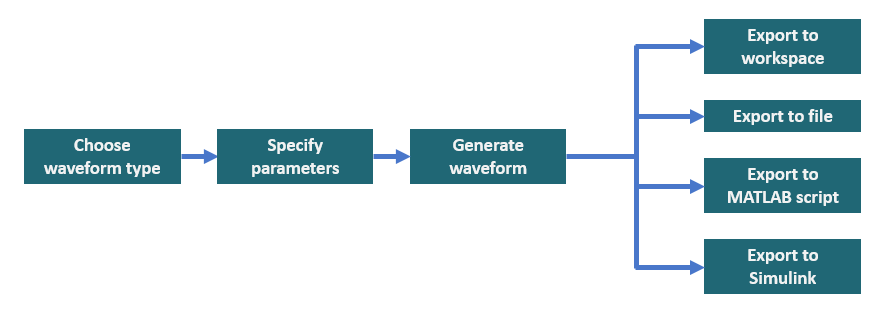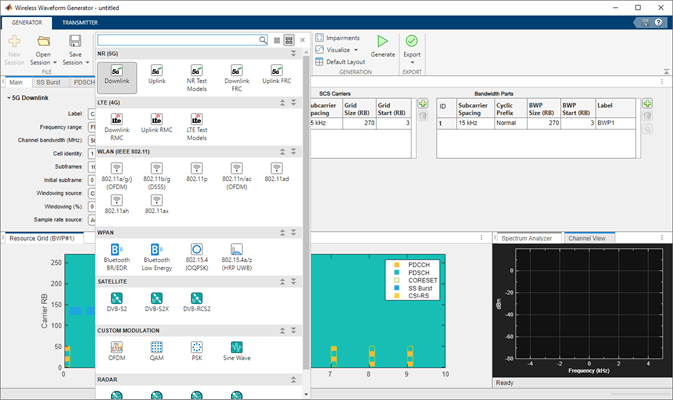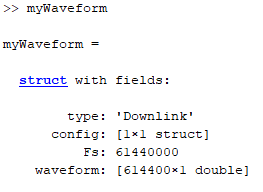5G NR 波形生成
此示例概述了 5G NR 波形生成工作流以及您可以使用 5G Toolbox™ 产品生成的波形类型。
简介
使用 5G Toolbox 功能,您可以配置和生成以下 NR 波形。
NR 测试模型 (NR-TM)
NR 上行链路和下行链路固定参考信道 (FRC)
NR 下行链路波形
NR 上行链路波形
要配置和生成具有静态参数集的波形,您可以使用以下工作流中的任何一个。您可以在测试和测量应用程序中使用通过这些工作流生成的波形。
使用5G 波形发生器,该 App 提供了用来配置波形的用户界面 (UI)。由于 5G 波形具有大量参数,因此,对波形进行参数化时建议使用该 App。借助该 App,您能够直接在其中生成波形,或将波形配置导出到 MATLAB® 以便通过命令提示符生成波形。通过该 App,您还能够将波形配置导出到 Simulink™。
使用
nrWaveformGenerator函数,它提供了一个编程接口,用于通过配置对象来配置波形。
要了解如何配置和生成具有动态变化参数的波形(例如,在对 5G 链路进行建模时),请参阅 NR PDSCH Throughput和 NR PUSCH Throughput示例。
要了解如何配置和生成物理随机访问信道 (PRACH) 波形,请参阅 5G NR PRACH Configuration和 5G NR PRACH Waveform Generation示例。
使用 App 配置和生成 5G 波形
5G 波形发生器提供了一个 UI,用来管理大量配置参数。在该 App 中,您可以选择波形类型,指定参数,生成和导出波形。通过该 App,您还能够与测试和测量设备进行交互。下图显示了在该 App 中生成和导出 5G 波形的常用工作流。

打开 5G 波形发生器
在 App 选项卡中的信号处理和通信下点击 5G 波形发生器对应的图标即可打开该 App。

选择波形类型
在该 App 中,您可以选择各种波形类型。利用下行链路和上行链路选项,您能够完全自定义波形的内容。您还可以生成 NR-TM、下行链路 FRC 和上行链路 FRC。

指定参数
在该 App 中,您可以指定参数。当您设置参数时,该 App 会立即更新资源网格可视化内容,显示波形中所有物理信道的位置。资源网格视图包含所有端口上所有物理信道位置的并集(也就是说,可视化不会区分每个端口发送的内容)。由于资源网格的最大分辨率是一个资源块 (RB),因此可视化不会使用单个资源元素 (RE) 来显示信号。
下图显示了两个物理下行链路共享信道 (PDSCH) 的配置。第一个 PDSCH 跨所有时隙,并使用物理资源块 (PRB) 0 到 100。第二个 PDSCH 在时隙 0 到 2 和时隙 4 到 6 中处于活动状态,并使用 PRB 200 到 250。

生成波形
要在该 App 中生成配置的波形,请点击生成。该 App 在发生器内部创建基带同相和正交 (IQ) 分量样本。您可以在频谱分析仪选项卡中查看生成的信号的频谱。
导出波形
要导出波形,请点击导出并选择可用选项之一。您可以将波形导出到工作区、文件、MATLAB 脚本或 Simulink 模型。

导出到工作区选项用于在 MATLAB 工作区中创建一个结构体。该结构体包含波形样本、采样频率和配置参数,以及一个描述波形类型(下行链路、上行链路、测试模型、下行链路 FRC 或上行链路 FRC)的字符串。例如:

导出到文件选项用于将波形保存为
.mat或.bb基带文件。导出到 MATLAB 脚本选项用于创建一个 MATLAB 脚本。可以在 MATLAB 命令行窗口中运行该脚本来生成配置的波形。
导出到 Simulink 选项用于生成一个 Waveform From Wireless Waveform Generator App 模块。可以将该模块用作 Simulink 模型中的波形源。
使用 MATLAB 代码配置和生成 5G 波形
nrWaveformGenerator 函数提供了一个编程接口,用于通过配置对象来配置波形。您可以在 5G 波形发生器中配置波形,并将此配置导出到 MATLAB 脚本中,而无需手动指定所有参数(这样做非常耗时)。您可以修改并运行此 MATLAB 脚本来生成配置的 5G 波形。
使用该 App 具有以下优点。
该 App 包括 UI 控件,例如用于选择值的下拉列表。
当您设置自定义值时,某些 UI 控件包括验证。
网格可视化功能使您能够在指定参数时查看信号的外观。
例如,本节中的代码示例使用 nrDLCarrierConfig 配置对象生成 5G 下行链路波形。您在该 App 中使用导出到 MATLAB 脚本选项为下行链路波形生成的代码也使用 nrDLCarrierConfig 配置对象。
创建默认的下行链路波形配置对象。waveconfig 对象包含完整的波形规范,并且是完全可配置的。
waveconfig = nrDLCarrierConfig
waveconfig =
nrDLCarrierConfig with properties:
Label: 'Downlink carrier 1'
FrequencyRange: 'FR1'
ChannelBandwidth: 50
NCellID: 1
NumSubframes: 10
InitialNSubframe: 0
WindowingPercent: 0
SampleRate: []
CarrierFrequency: 0
SCSCarriers: {[1×1 nrSCSCarrierConfig]}
BandwidthParts: {[1×1 nrWavegenBWPConfig]}
SSBurst: [1×1 nrWavegenSSBurstConfig]
CORESET: {[1×1 nrCORESETConfig]}
SearchSpaces: {[1×1 nrSearchSpaceConfig]}
PDCCH: {[1×1 nrWavegenPDCCHConfig]}
PDSCH: {[1×1 nrWavegenPDSCHConfig]}
CSIRS: {[1×1 nrWavegenCSIRSConfig]}
设置配置参数后,调用编程式波形发生器。
[waveform,waveformInfo] = nrWaveformGenerator(waveconfig);
绘制频谱图,在频域中可视化信号。此波形包括一个全分配 PDSCH、一个物理下行链路控制信道 (PDCCH) 和信号同步 (SS) 突发。
% Plot spectrogram of waveform for first antenna port samplerate = waveformInfo.ResourceGrids(1).Info.SampleRate; nfft = waveformInfo.ResourceGrids(1).Info.Nfft; figure; spectrogram(waveform(:,1),ones(nfft,1),0,nfft,'centered',samplerate,'yaxis','MinThreshold',-130); title('Spectrogram of 5G Downlink Baseband Waveform');

将 PDSCH 分配更改为跨 PRB 0 到 10。生成波形并绘制频谱图。
waveconfig.PDSCH{1}.PRBSet = 0:10;
[waveform,waveformInfo] = nrWaveformGenerator(waveconfig);
% Plot spectrogram of waveform for first antenna port
samplerate = waveformInfo.ResourceGrids(1).Info.SampleRate;
nfft = waveformInfo.ResourceGrids(1).Info.Nfft;
figure;
spectrogram(waveform(:,1),ones(nfft,1),0,nfft,'centered',samplerate,'yaxis','MinThreshold',-130);
title('Spectrogram of 5G Downlink Baseband Waveform');
您可以定义物理信道和信号的多个实例。创建 PDSCH 配置对象的第二个实例,并将分配设置为跨 PRB 40 到 50 和 OFDM 符号 2 到 10。
mySecondPDSCH = nrWavegenPDSCHConfig; mySecondPDSCH.PRBSet = 40:50; mySecondPDSCH.SymbolAllocation = [2 10];
将第二个 PDSCH 配置分配给波形配置。生成波形。
waveconfig.PDSCH{2} = mySecondPDSCH;
[waveform,waveformInfo] = nrWaveformGenerator(waveconfig);
% Plot spectrogram of waveform for first antenna port
samplerate = waveformInfo.ResourceGrids(1).Info.SampleRate;
nfft = waveformInfo.ResourceGrids(1).Info.Nfft;
figure;
spectrogram(waveform(:,1),ones(nfft,1),0,nfft,'centered',samplerate,'yaxis','MinThreshold',-130);
title('Spectrogram of 5G Downlink Baseband Waveform');